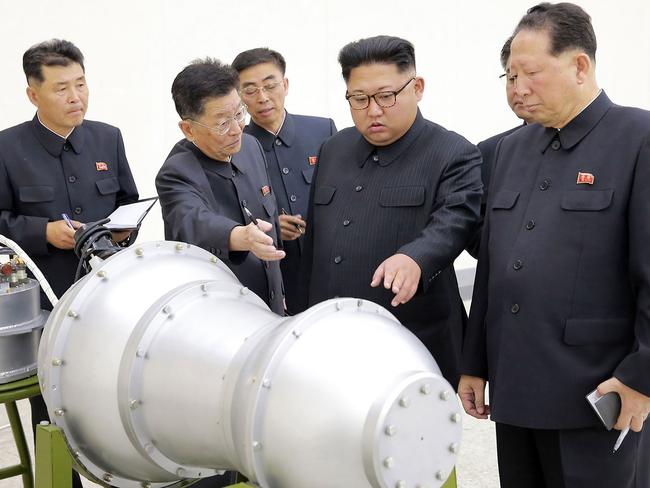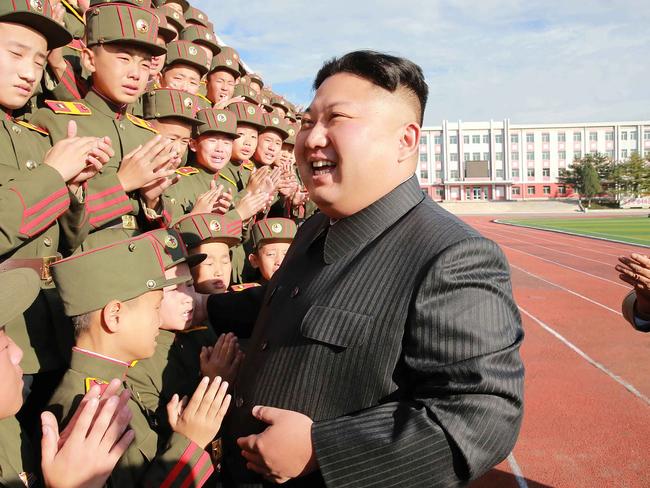North Korea: Nuclear EMP attack ‘biggest threat’ to US
WITH one powerful weapon, North Korea has the potential to shut down America and kill millions of people.
TWO members of the now disbanded congressional Electromagnetic Pulse (EMP) commission told a recent House Homeland Security subcommittee hearing that a nuclear EMP attack remained the “biggest threat” facing the US today.
They warned the US could face a “doomsday scenario” if Pyongyang gets hold of an EMP capable nuke.
The powerful weapon has the potential to shut down America’s power grid and kill millions of people.
North Korea has tested several intercontinental ballistic missiles this year and claimed to have successfully tested a miniaturised hydrogen bomb on September 3.
The secretive state claimed such a bomb could be detonated at high altitudes for “super-powerful EMP attack according to strategic goals”.
Chairman of the now defunded EMP commission William Graham and its former chief of staff Peter Vincent Pry told the hearing an EMP attack would be devastating.
“The result could be to shut down the US electric power grid for an indefinite period, leading to the death within a year of up to 90 per cent of all Americans,” they said such an attack remains unlikely.
dismissed the committee’s concerns.
Greg Austin, a professor in cyber security at UNSW told news.com.au, “The scenario of an EMP attack is highly unlikely, as unlikely as a direct nuclear attack on ground targets in South Korea or Australia.”
A nuclear EMP attack destroys electronics and blackout supplies, meaning everyday modern day activities would grind to a standstill.
The hearing also heard how the US missile defence system may not adequately protect the country from a North Korean missile.
“Current US BMD systems are not arranged to defend against even a single ICBM that approaches the United States from over the South Polar region, which is the direction toward which North Korea launches its satellites,” the committee was told.

Nuclear disarmament campaigner John Hallam said the EMP threat is real and is more or less as bad as it’s said to be.
Mr Hallam said it was clear the DPRK has at least one sufficiently large thermonuclear warhead and that the country has been given a design for an EMP-enhanced warhead.
“Whereas the DPRK will have one or two EMP-enhanced thermonuclear warheads, China and Russia will have had them for decades,” he said.
“EMP is hardly new — in the 80s, the US (and Russia and China) went to considerable expense to EMP-Harden their communication systems, especially military ones.”
Mr Hallam said Russia and China also went to a great deal of trouble to EMP-proof their communication systems.
He said use of such a weapon remained incredibly dangerous.
“In the years since the cold war, the US has farmed out even its most critical military communications systems to private enterprise, who obviously don’t EMP-proof things,” he said.
“Also our entire society has become much more dependent on microchips, and on electronic transactions.
“Notably the financial system, where for example, stocks and shares are apparently traded electronically by algorithms that do it thousands or at least hundreds of times a minute.”
Mr Hallam added EMP remains a real and potentially fatal technical vulnerability for all wired societies.

“Not just because of the DPRK, but because it’s part of a trend in which fatal technical flaws are ignored until disaster strikes because it’s convenient in the short term to do so,” he said.
“EMP is real. Every government with a highly developed nuclear weapons program plans to use it, including the US itself.
“The DPRK may well be able to explode an EMP weapon and take the US back to the 18th century in a few milliseconds.
“It’s going to be ugly and messy and lots of people are going to starve to death if they leave it too late to loot the supermarket across the road, whose just-in-time ordering system has not simply broken down but vanished along with my bank account, gas, electricity, water, petrol, smartphone etc,” he said.
BLACKOUT BOMBS
Just last week, South Korea announced it is building graphite bombs which could paralyse North Korea’s power grid in the event of a nuclear war.
Also known as “blackout bombs” they work by spreading chemically-treated carbon graphite filaments over electric facilities to short-circuit and disrupt the electricity grid.
The weapons have been developed by South Korea’s Agency for Defence Development, as one element of the Kill Chain pre-emptive strike program.
The program is designed to detect, identify and intercept incoming missiles in the shortest possible time.
It works with Korea’s Air and Missile Defence system and only affects targeted electrical power systems.
According to Fox News, North Korea would be paralysed by such a bomb.

Kim would be cut off from his population since communication would be offline while its government and military would be instantly crippled.
Mr Hallam said there were differences between a graphite and EMP bomb.
“A graphite bomb simply sprays graphite, which is a form of carbon, everywhere and it creates short-circuits,” he said.
“Whereas an EMP is an electromagnetic pulse, which creates an electrical potential across things, burning them out permanently.”
Mr Hallam said you would need a lot of graphite bombs to attack North Korea, which was nowhere near as dependent on electronics as the South or the US.
HOW DO GRAPHITE BOMBS WORK?
The bombs rely on the same ingredient as the humble, everyday, ordinary pencil — graphite.
Inside the bomb is graphite filament and graphite is a highly efficient electricity conductor.
Unlike conventional explosives, graphite bombs do not strike the target and blow up. The graphite bomb instead explodes in the air above a power plant.

When it explodes, the graphite filaments are so fine that they seem like a cloud. The bomb unleashes this cloud of graphite particles across the electricity system.
The graphite causes short circuits and electrical discharges, blowing safety devices and burning out essential parts in the electrical supply. The blackout graphite cloud can hit power plants, transformer stations, power lines and more.
The result is darkness. A nation’s electricity suddenly stops without warning.
NORTH KOREAN CYBER POWER
Bombs that target electricity supplies aren’t the threats the west faces.
Western nations also face increasing cyber attack from North Korean hackers whose abilities are improving, the New York Times reported.
According to The Times, Pyongyang has been developing a cyberprogram that is capable of unleashing global havoc.
Chris Inglis, a former deputy director of the National Security Agency, said Cyber is a tailor-made instrument of power.
“There’s a low cost of entry, it’s largely asymmetric, there’s some degree of anonymity and stealth in its use,” he said.
“It can hold large swathes of nation state infrastructure and private-sector infrastructure at risk. It’s a source of income.”
NUCLEAR FOOTBALL
Despite North Korea’s array of powerful weaponry, the rogue nation is still focusing on nuclear power.
On Friday, a North Korean diplomat, who Russian news reported as a member of North Korea’s US Studies Department, said Pyongyang would continue nuclear testing in the interest of self-defence.
“The Democratic People’s Republic of Korea is constantly being convinced that developing nuclear weapons is the right choice. And we are strengthening our intention to conduct tests in order to offset the nuclear threat from the US.”
The Russian report also quoted him as telling the same event that Trump had “thousands” of nuclear weapons at his disposal and that the US leader was playing “nuclear football”.
— with Fox News



